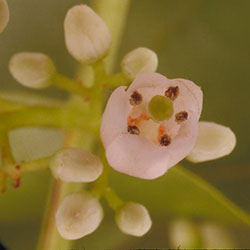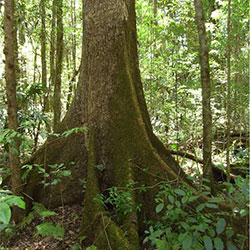Toona ciliata
 |
 |
Australian Red Cedar
Commonly known as the red cedar, Toona ciliata is a large rainforest tree up to a height of 40–60 metres, which ranges from southern parts of Asia through New Guinea into Australia. In Australia it is found on the east coast between southern Queensland and northern New South Wales.
Due to its size and valuable timber this species has been extensively logged since European settlement. The timber is used in cabinetry for its softness, texture and rich red colour, hence the common name red cedar.
The bark of a juvenile is smooth, although mature trees have scaly, fissured bark. Even as a juvenile tree, the buttress root will be identifiable, and will develop to be quite protruding. The white or soft pink flowers are 5mm in diameter, in a 30–40 cm inflorescence and bloom in late spring (November to January). The fruit is a thin, dry, woody capsule, which splits into five valves. Fruit will develop from late summer (February to March). The seeds inside have a papery, wing shape appendage which is used in wind dispersal. Fruiting will commence from six to eight years of age. The leaves are 15–45cm long and pinnate with 6 leaflet pairs. As one of Australia’s native deciduous trees, the leaves will fall in autumn (late March) and grow back in spring (early September). The new leaf growth is reddish pink colour.
Toona ciliata requires well-drained soils with a deep profile and a high nutrient load. A cover of leaf litter is preferred, which would mimic its natural habitat.
Habit of growth and tree structure depends greatly on the habitat. In sheltered areas of forest which are protected from direct sunlight, Toona ciliata has a characteristic, straight, "gun barrel" trunk which stretches to the top of the canopy. This form is ideal for timber use. Trees in open, exposed areas are shorter and have large spreading canopies, ideal for shade trees. Some scorching can be expected on the western-facing leaves of trees in exposed sites.
Seeds should be fresh to maximise recruitment success. Scoring or removing some flesh from the seed can help germination, which may take up to 12 months. Cuttings can be taken and propagated. However, seed germinated trees tend to have a stronger root system.
Seedlings are sensitive to lack of water (drought), fire and weed competition. Seedlings should be protected in partial shade to avoid bleaching of leaves. Trees, however, are frost hardy. The Cedar tip moth, or shoot-borer, Hypsipyla robusta, is a pest which eats out the new shoots pith. This moth larva is particularly a problem on juvenile trees, and will cause premature branching out.
This tree is recommended for large gardens as a feature or structural element.
Brittany Turner, Volunteer Botanical Training Program Participant 2017
Name meaning: Toona ciliataToona - from toon or tun, an Indian name for this tree ciliata - derived from Latin, meaning having fine hairs, which relates to the fine hairs on the edge of the leaf or leaf margin, which resemble an eyelash |
References:
Australian Tropical Rainforest Plants Edition 6 (RFK6). Toona ciliata M. Roem. Available at https://www.anbg.gov.au/cpbr/cd-keys/rfk/ [Accessed February 2017].
Gaddes, A. (1990) Red Cedar, Our Heritage. Wyndham Observer.
Howe, A. (2017) ANBG Horticulturalist. Pers. comm.
Noosa Integrated Catchment Association (2017) Toona ciliata. Available at http://noosasnativeplants.com.au/plants/479/toona-ciliata-(was-toona-australis) [Accessed February 2017].
Orwa, C., Mutua, A., Kindt, R., Jamnadass, R., Anthony, S. (2009) Agroforestree Database: a tree reference and selection guide version 4.0. World Agroforestry Centre, Kenya.
Taylor, M. J. &. Harden, G. J. (1991) Toona ciliata M. Roem. in PlantNET (The NSW Plant Information Network System). Royal Botanic Gardens and Domain Trust, Sydney. Available at http://plantnet.rbgsyd.nsw.gov.au/cgi-bin/NSWfl.pl?page=nswfl&lvl=sp&name=toona~ciliata [Accessed February 2017].
Ritchie, R. in Sripathy, V. (ed) (2004) Red Cedar in Australia. Historic Houses Trust of NSW.
Rural Industries Research and Development Corporation, Land & Water Australia, FWPRDC, MDBC Joint Venture (2005) Growing Australian Red Cedar and Other Meliaceae Species in Plantation. Rural Industries Research and Development Corporation, Canberra. 04/135. Available at https://rirdc.infoservices.com.au/downloads/04-135.pdf [Accessed February 2017].
Vander, J. (1987) Red Cedar: the tree of Australia’s History. Reed Books Pty Ltd.
Vander, J. (2002) Red Gold: the tree that built the nation. New Holland Publishers Pty Ltd.
![An Australian Government Initiative [logo]](/images/austgovt_brown_90px.gif)


